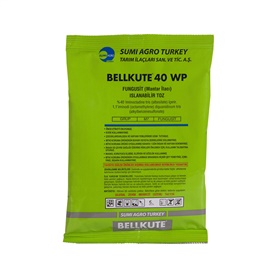

Category: PLANT PROTECTION
Type: FUNGICIDE
Plant protection product BELLKUTE 40 WP is a fungicide classified as Group M7 according to its mechanism of action.
Active substance: Contains 40% Iminoctadine tris (albesilate).
Benefits
Phytotoxicity when used at the desired dose.
Wide Spectrum,
It is a protective fungicide.
Practical Tips
The required amount of the drug is first mixed with some water in a separate container. The sprayer is filled to half and poured into this mixture and the remaining amount of water is added and mixed.
It should be applied after dew in the early morning or in the afternoon in cool weather conditions.
It is miscible with all insecticides and fungicides except those with strong alkali properties. However, it is appropriate to perform a premix test before spraying.
It is not used in areas where harvesting of vineyard leaves for consumption purposes.
Repetitive applications of plant protection products with the same mechanism of action promote resistance development. Therefore, in order to delay the development of resistance, do not exceed the recommended number of applications of the plant protection product during the same production season. In cases where the application should be repeated, pay attention to the use of plant protection products with different mechanism of action.
Usage
Preparation of the drug for application: The required amount of the drug is first mixed with some water in a separate container. The sprayer is filled with water up to half and the mixture is poured into it and the remaining amount of water is added and mixed.
Application: Since it is a contact fungicide, it is recommended to start spraying when the first signs of disease appear and apply a good coating spraying. The application should be continued with an interval of 10 days depending on the disease development.
Karaleke in Apple; 1. When spraying flower eyes blister, 2. Spraying during the pink flower bud, 3. Spraying should be done when 70-80% of flower petals are poured.
Powdery mildew in cucurbitaceae: Spraying should be started as soon as the symptoms are seen.
Brown spot disease in citrus: When the first disease symptoms are seen, spraying should be started when the shoots are 5-10 cm in length. The application is repeated according to the disease development at intervals of 10-14 days.
Monilya in Apricot: First spraying should be done at the beginning of flowering (when 5-10% of flowers bloom), second spraying should be done at full flowering (when 90-100% of flowers bloom).
Powdery mildew in the vineyard: First spraying, when the shoots are 25-30 cm long, the second spraying; When the flower petals are shed (the period when the ridges take the ridiculous grain size), the third and other treatments should be done at intervals of 10 days depending on the development of the disease. Spraying should be stopped when fresh water is applied to the grains.
For Lead Mold in Tomato and Pepper: When the first symptoms of the disease are seen in the environment or when the plants are in the flowering period, the application is started. Disinfection should be continued with 10 days intervals according to the disease development.
Early Leaf Blight in Watermelon: Application should be started when the first signs of disease are seen. Disinfection should be continued at intervals of 10 days according to the development of the disease.
Sosyal Ağ